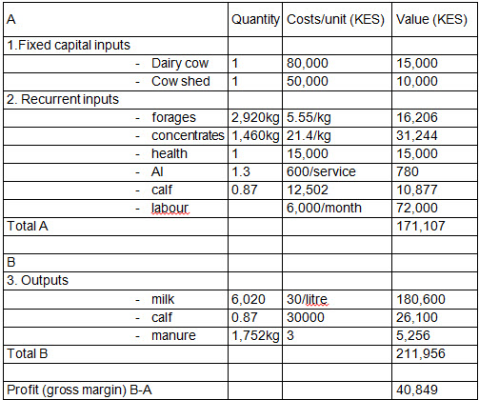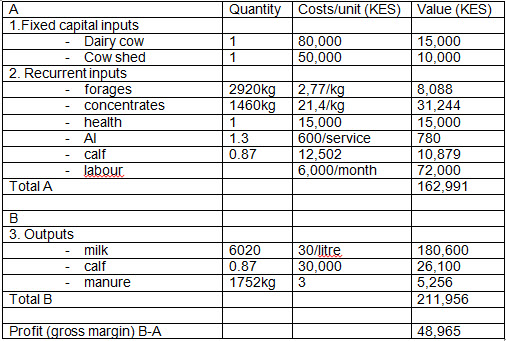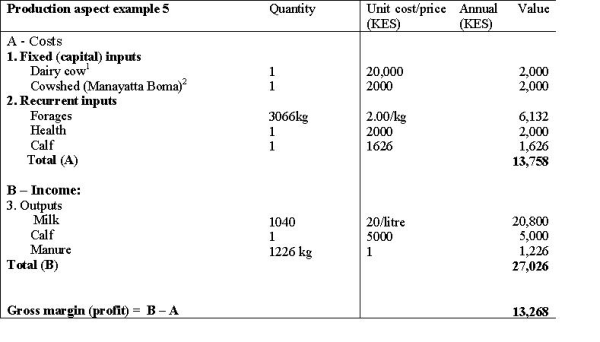Credit: Biovision-Infonet
Economics of Dairy production: Estimation of returns from different scenarios of smallholder systems
Dairy farming is an important source of income and employment in Kenya. The population of dairy cattle is estimated to be about 3 million in the country. Milk production in Kenya is predominantly by small scale farmers, who own one to three dairy animals, and produce about 80 percent of the milk in the country. Smallholder dairy production systems range from intensive stall-fed cut-and-carry systems, supplemented with purchased concentrate feed, to free grazing on unimproved natural pasture in the more marginal areas.
Extensive systems are confined to a few ranches and large scale farms. The intensive systems are the most predominant and comprise zero-grazing and semi-zero grazing systems. Upgraded dairy breeds tend to be kept in stall-feeding units, cross-bred cattle in semi-zero-grazing systems, and zebu cattle in free-grazing systems. It is estimated that 50% of the milk is marketed but only 20% of that milk is marketed through the formal channels. The average yield is estimated to be 560 kg per cow per year. Arising from reports and data collected by different institutions, a rough estimate of returns obtainable from dairy enterprise can be calculated. The important inputs for dairy production include land, labour and capital.
Land
Land is the most important resource for feed production besides being used for infrastructure development. Estimates of land required to raise a livestock unit (cow and calf) under different scenarios vary with ecological zone, forage management practices, and feeding strategies. For instance, under intensive forage production in high rainfall (e.g. UH 2- 4; LH 2-4; UM 1-4, LM1-3 click here to see more about Agro-Ecological Zones, one acre can sustain a livestock unit. In areas with low rainfall, the acreage required to sustain a livestock unit increase drastically and may reach 10 acres under moderate management. In fertile areas the land is more valuable and scarce.
Labour
Dairy production is generally labour intensive regardless inclining towards machinery or human to perform tasks. Woman do the majority of the work involved in keeping dairy cows and the marketing of milk. Labour is generally estimated to take about 40-50% of the total cost.
Capital
The most important capital in dairy industry are the cows and construction of management infrastructure (shed, milking crushes, fencing, and husbandry apparatus/equipment). The cost of an in-calf heifer vary from Ksh 40,000-120,000/- (USD 540-1600) depending on genetic potential. Simple cow sheds for holding upto 4 cows are estimated to cost (Ksh 50,000-100,000/- ) depending on source of materials and labour. The cost can be substantially reduced by using own timber, building stones, rainwater and home labour during construction. Important recurrent costs include purchase of feeds, artificial insemination, health care and milk marketing (transport, preservation and value addition).
Estimated returns from dairy systems based cows with varied production potential under different managements (production inputs)
The following 5 examples of how to calculate economic returns from dairy cattle should only be taken as guidelines. It is very important that each dairy farmer calculates production figures based on available feedstuffs in the area, what can be grown on the farm and the cost of growing it, as well as the price of milk that can be obtained from the market. Under Animal Nutrition and feed rations it is described what dairy cows need in terms of nutrition. Each dairy farmer must decide the best possible production system fitting to the local circumstances at the most economical costs in order to get a decent income from dairy production.
Also health and welfare of the animals see under Animal welfare and organic norms for further information are very important aspects, for the animals as living beings but also in an economic way for too many veterinary bills or loss of productive animals are very costly affairs. It is always prudent to reduce costs as much as possible bearing in mind that some costs like basic nutrition, health and animal welfare are the cornerstones of a profitable dairy production.
General assumptions:
- A dairy cow consumes feed dry matter (DM) amounting to 3% of its body weight daily
- Average fertility rate is 0.87: a cow gives 0.87 calf per year
- No mortality occurs
- The calf is raised successfully as replacement stock or sold after attainment of physiological maturity
- Artificial insemination (AI) is practiced under intensive and semi-intensive systems. Natural mating is practiced under extensive/pastoral systems
- There is unlimited milk market
- Milk is sold at farm gate without value addition or any form of processing
- For organic milk no bonus on the milk price is calculated
- Labour costs vary with systems and locality
- Labour is not hired under pastoral system
Example 1: Dairy cow (Friesian or Ayrshire) weighing 400 kg kept in high potential highlands of Kenya (UH, LH, UM or LM climate) under intensive or zero grazing management based on outsourced (bought) feeds.
Daily diet example
| Feed stuff | Amount dry matter (DM) basis(kg) | Amount Fresh(kg) | Total DM per year | Price per kg DM(in KES) |
| Napier grass (20% DM)(kg) | 5 | 25 | 1,825 | 5.55 |
| Lucerne (90% DM)hay(kg) | 3 | 3.5 | 1,095 | 5.55 |
| Dairy meal (90%) DM (kg) | 4 | 4.5 | 1,460 | 21.4 |
| Maclick super | 0.12 | 0.12 | 44 | 10 |
| Total/average | 12.12 | 33.12 | 4424 | 10.8 |
Note:
- Forages with low DM content to be weighed fresh and wilted before feeding.
- Fresh water to be available free choice
- Wastages to be compensated for during feeding

*Calculations based on average daily milk = 20 litres in 301 days lactation
Example 2: Dairy cow (Friesian or Ayrshire) weighing 400 kg kept in high potential highlands of Kenya (UH, LH, UM or LM climate) under intensive or zero grazing management based on home grown forages.
Daily diet example
| Feed stuff | Amount dry matter (DM) basis(kg) | Amount Fresh(kg) | Total DM per year | Price per kg DMin KES |
| **Napier or Columbus or Guinea grass or combination | 3 | 15 | 1,095 | 2.77 |
| **Kikuyu or Rhodes or Star grass or combination | 2 | 8 | 730 | 2.77 |
| *Sweet potato vines or Lucerne or desmodium | 2 | 13.5 | 730 | 2.77 |
| **Calliandra or Sesbania or Leucaena | 1 | 5 | 365 | 2.77 |
| ***Dairy meal | 4 | 4.5 | 1,460 | 21.4 |
| Maclick super | 0.12 ( 120 g) | 0.12 ( 120 g) | 44 | 10.0 |
| Total | 12.12 | 46 | 4010 | 7.71 |
Note:
- Forages with low DM content to be weighed fresh and wilted before feeding.
- Fresh water to be available free choice
- Wastages to be compensated for during feeding

From the above comparison it can be seen that home production of forages gives a higher return from similar systems, but that dairy production can still be profitable when fodders are bought in (depending on price).
Example 3: Dairy cow (Friesian or Ayrshire) weighing 400 kg under intensive management in a peri-urban area fed on purchased forages, agro-industrial by products and concentrates based diets.
Daily diet example
(all feeds 90% DM except brewer’s waste)
| Feedstuff | Kg dry matter | Kg Feed | Total DM/year | Price/kg DM in KES |
| Grass hay | 4 | 4.5 | 1460 | 3.33 |
| Molasses | 1 | 1 | 365 | 8.00 |
| Brewer’s waste (5% DM) | 1 | 20 | 365 | 8.00 |
| Lucerne hay | 1 | 1 | 365 | 3.33 |
| Sunflower or cotton seed cake | 2 | 2 | 730 | 8.00 |
| Dairy meal | 3 | 3.5 | 1095 | 21.4 |
| Maclick Super | 0.12 | 0.12 | 44 | 10.00 |
| Total Average | 12.12 | 31.12 | 4424 | 9.4 |
Note:
- 1. Forages with low DM content to be weighed fresh and wilted before feeding.
- 2. Fresh water to be available free choice
- 3. Wastages to be compensated for during feeding

Example 4: Jersey cow weighing 300 kg under intensive system (zero grazing) in Western or Eastern Kenya (UM or LM climate) receiving at least 800 mm rainfall fed on home grown forages.
Daily diet example
| Feed | Kg dry matter | Kg Feed | Kg DM/Year | Price per kg DM inn KES |
| Napier or Columbus or Genua or Giant panicum or Guatemala grass or combination | 2 | 10 | 730 | 4 |
| Kikuyu or Rhodes or Nandi Setaria or Star grass or combination | 2 | 8 | 730 | 4 |
| Sweet Potato vines or Lucerne or desmodium | 1 | 7 | 365 | 4 |
| Calliandra or Sesbania or Leucaena | 1 | 4 | 365 | 4 |
| Dairymeal | 3 | 3,5 | 1095 | 21,4 |
| Maclick super | 0,12 | 0,12 | 44 | 10 |
| Total | 9,12 | 32,62 | 3329 | 9,8 |
Assumptions:
* DM content = 15%;
* *DM content = 20%;
***DM content = 90%
Note:
- Forages with low DM content to be weighed fresh and wilted before feeding.
- Fresh water to be available free choice
- Wastages to be compensated for during feeding

Example 5. Pastoral system keeping dual-purpose Sahiwal cow under IL conditions grazing good quality pasture (Themeda, Bothriochloa, Cynodon, Cenchrus or a mixture of these)
